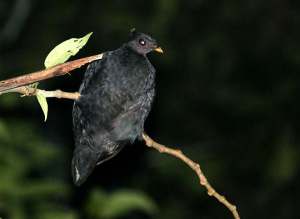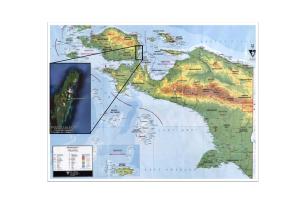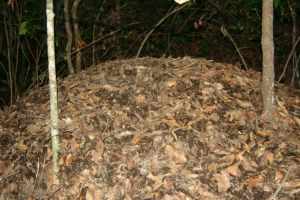Freddy Pattiselanno (Megapode Specialist Group; Animal Science Laboratory, Universitas Negeri Papua, Manokwari)
 There are 22 species of Megapodes (Megapodiidae, Galliformes) that rely on external sources of heat to incubate their eggs: bury in volcanic soils, in soils heated by the sun or in mounds of rotting leaves (Jones et al., 1995). It was recognized that 15 species of megapode species were found in Indonesia (Argeloo and Dekker, 1996). Megapodius freycinet (Gaimard) known as Dusky Scrubfowl (Sujatnika et al. 1992) or Dusky Megapode (Argeloo, 1997), classified as Indonesian endemic birds that geographically distributed among North Mollucas, New Guinea and its satellite islands (Rand and Gilliard, 1967; Sujatnika et al. 1992).
There are 22 species of Megapodes (Megapodiidae, Galliformes) that rely on external sources of heat to incubate their eggs: bury in volcanic soils, in soils heated by the sun or in mounds of rotting leaves (Jones et al., 1995). It was recognized that 15 species of megapode species were found in Indonesia (Argeloo and Dekker, 1996). Megapodius freycinet (Gaimard) known as Dusky Scrubfowl (Sujatnika et al. 1992) or Dusky Megapode (Argeloo, 1997), classified as Indonesian endemic birds that geographically distributed among North Mollucas, New Guinea and its satellite islands (Rand and Gilliard, 1967; Sujatnika et al. 1992).
Considering some threats to the bird nesting such as agriculture development, secondary plant invasion, uncontrolled eggs harvesting, and habitat loss (Shannaz et al. 1992), we then conducted a briefly observation on the nesting ground along the coastal area of Rumberpon islands, and identify the possible threats occur in the sites.
Where is Rumberpon Island?
 Rumberpon Island was located on 134o8’-134o15’E, 01o44’-01o75’S. Study site is approximately 18,000 ha tract of upland in northern part of Cenderawasih Bay. Mean annual rainfall is 2648,3 mm, daily temperature is about 21,1-31,1oC and the humidity is 83. Botanically, the coastal area is grown by vegetation from varies family such as Areceae, Fabaceae, Combretaceae and Rhizoporaceae, whereas the foothill up to the hilly vegetations which found are: Verbanaceae, Sapindaceae and Malvaceae.
Rumberpon Island was located on 134o8’-134o15’E, 01o44’-01o75’S. Study site is approximately 18,000 ha tract of upland in northern part of Cenderawasih Bay. Mean annual rainfall is 2648,3 mm, daily temperature is about 21,1-31,1oC and the humidity is 83. Botanically, the coastal area is grown by vegetation from varies family such as Areceae, Fabaceae, Combretaceae and Rhizoporaceae, whereas the foothill up to the hilly vegetations which found are: Verbanaceae, Sapindaceae and Malvaceae.
Nesting ground
Vegetation growth around the places was a tree plant from family Piperaceae, Malvaceae, Arecaceae, Fabaceae, Combretaceae and Rhizoporaceae. It was predicted that vegetations constructed around the area was a place for resting, playing and food searching. Atmawidjaja (1997) described that source of food, which required to the birds for living and growing was sufficiently supplied around the nesting ground habitat such as: fish, insect, worm and fruits.
Temperature and humidity were more influenced by the environment and vegetation around the nesting ground. Like other regions in Papua province, Rumberpon islands have wet tropic climate, which did not show the significance difference between dry and rainy season. Coastal areas with an open sand plain as nesting ground could be easily reached by sunlight during day time. Therefore, temperature around the nesting ground was ranged from 32-36oC with 60-65% of humidity. Argeloo (1997) stated that 32-35oC was the optimum temperature for burying Megapodes egg underground. While Heij (1995) as cited by Rompas (1997) quoted that E. wallacei laid their eggs in places with temperature ranged from 31-35oC.
Nest characteristic
Three new nests were found, approximately 60-100 meter far away from the coast line. Nests were located on the sand surface, 1m in height above the sea level. The nesting size is presented on Table 1.
Table 1. Nesting Size
|
Number |
Diameter (m) |
Height (m) |
|
|
1. |
6.0 |
0.5 |
|
|
2. |
3.5 |
0.5 |
|
|
3. |
4.5 |
1.5 |
|
|
Mean |
|
0.8≈1 |
 Rand and Gilliard (1967) indicated nesting mounds are frequently found in low open vegetation within 150 feet of the seacoast. They further explained that nests are up to six feet in height with flattened tips (some are at least fifteen feet in diameter) and very broad bases (some reach at least thirty feet).
Rand and Gilliard (1967) indicated nesting mounds are frequently found in low open vegetation within 150 feet of the seacoast. They further explained that nests are up to six feet in height with flattened tips (some are at least fifteen feet in diameter) and very broad bases (some reach at least thirty feet).
Burnie (1992) described that generally, birds nesting like a dish shape. From the observation, a Dusky Megapode nest is in volcano shape formed. It might probable that its shape is useful to keep nesting temperature stable, which is required to incubate the bird eggs. Moreover, this shape is beneficial to protect eggs from predator due to a huge size of eggs (48X43 mm).
Material compositions
Visual observation and material analysis was carried out after random sample specimen of nesting material was taken and the composition is shown in Table 2.
Table 2. The average composition of nesting material
|
Material |
Weight (gram) |
|
Roots |
0.28 |
|
Leafs |
2.60 |
|
Oyster fragment |
6.22 |
|
Chopping woods |
63.35 |
|
Sand |
180.81 |
A composition of nesting material was dominated by sand (180.81 gram) and the smallest part was roots (0.28 gram). This composition describes that nesting material was easily found around the site, and sand was a dominant part, possibly because it may simply be formed to a volcano shape, and performed as a source of alternative heat for hatching the eggs. Other materials in small parts were a heat source through the rotten process.
According to Petocz (1987), Megapode family built their nest from a heap of sand and litter. Argeloo (1997) reported that “the eggs are not incubated by body heat but through alternative heat sources like the sun, volcanic activity or heat produced by rotten materials like leafs and branches.” Jones, et al., (1995) described that eggs are put in the sandy places near the beach and are not incubated by the birds.
Note: full article was published in Tigerpaper Vol 32(3):20-222; pictures were taken from relevance website

I am really inspired together with your writing abilities as well as with the
layout in your weblog. Is this a paid topic or did you customize it your self?
Anyway keep up the nice quality writing, it is rare to look a
nice weblog like this one nowadays..
Thank you so much for visiting this site
Thank you for having a visit to a blog. This is customised by me.